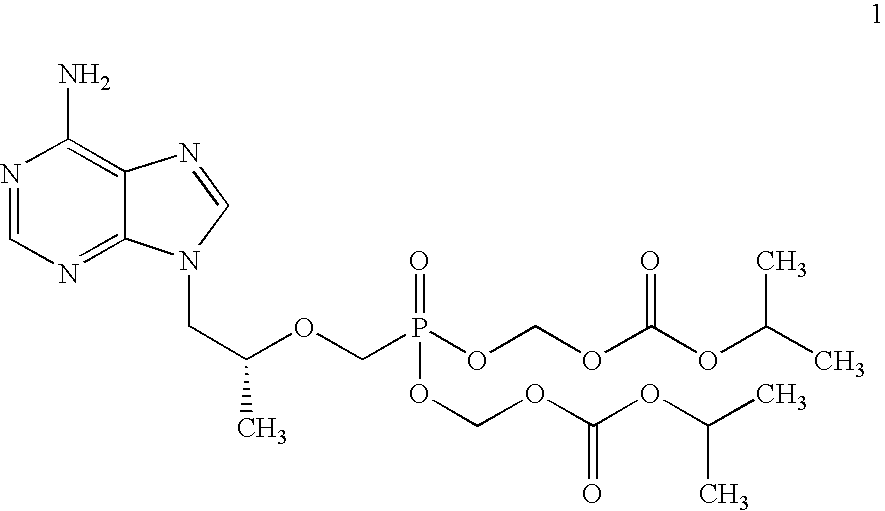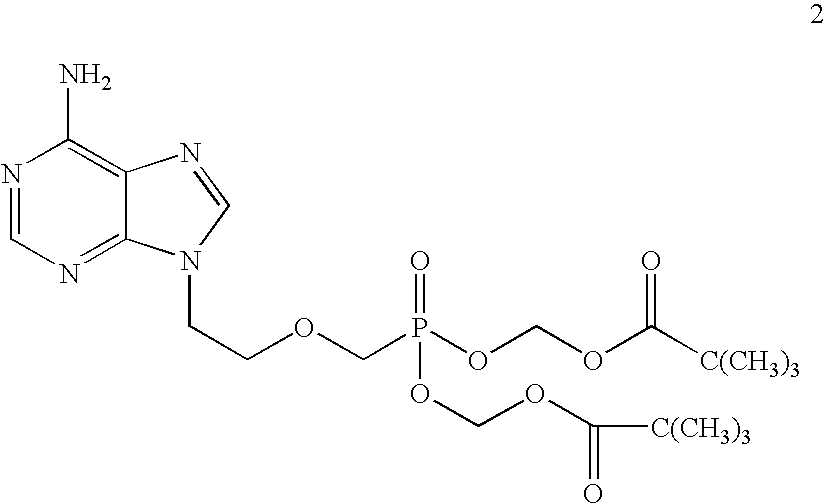Novel process for acyclic phosphonate nucleotide analogs
a technology of acyclic phosphonate and nucleotide analog, which is applied in the field of new process for the preparation of acyclic phosphonate nucleotide analog, can solve the problems of nsup>4/sup>-alkylated impurities, higher amounts of corresponding mono ester impurities, and lower yields of products
- Summary
- Abstract
- Description
- Claims
- Application Information
AI Technical Summary
Problems solved by technology
Method used
Image
Examples
example 1
Step-I
[0061](R)-9-(2-phosphonomethoxypropyl)adenine (14 gm) is dissolved in dimethylformamide (60 ml) and dimethylformamide dimethylacetal (21 gm) is added slowly at 25-30° C. for 10 minutes. The temperature is raised to 55° C. and maintained for 3 hours at 50-55° C. Then the solvent is distilled under vacuum at 75-80° C. to give 20 gm of (R)—N4-Dimethylaminomethyledino-9-(2-phosphonomethoxypropyl)adenine as residue.
Step-II
[0062]To the mixture of (R)—N4-Dimethylaminomethyledino-9-(2-phosphono methoxypropyl)adenine (20 gm), N-methyl-2-pyrrolidinone (80 ml) and triethyl amine (20 ml), chloromethyl-2-propyl carbonate (30 gm) is added slowly at 25-30° C. for 30 minutes, the temperature is raised to 60° C. and maintained for 4 hours at 55-60° C. Then the reaction mass is cooled to 25-30° C. Ethyl acetate (260 ml) is added and stirred for 20 minutes at 25-30° C. Filtered the salts on hi-flo bed and washed the ethyl acetate layer with water (140 ml), then washed with 10% sodium chloride (1...
example 2
Step-I
[0065]9-(2-Phosphonomethoxyethyl)adenine (20 gm) is dissolved in dimethyl formamide (80 ml) and dimethylformamide dimethylacetal (30 gm) is added slowly at 25-30° C. for 10 minutes. The temperature is raised to 55° C. and maintained for 3 hours at 50-55° C. Then the solvent is distilled under vacuum at 75-80° C. to give 28 gm of N4-dimethylaminomethyledino-9-(2-phosphono methoxyethyl) adenine as residue.
Step-II
[0066]To the mixture of N4-dimethylaminomethyledino-9-(2-phosphonomethoxy ethyl) adenine (25 gm), N-methyl-2-pyrrolidinone (100 ml) and triethylamine (38 gm), chloromethyl pivalate (57 gm) is added slowly at 25-30° C. for 30 minutes, the temperature is raised to 45° C. and maintained for 19 hours at 40-45° C. Then the reaction mass is cooled to 25-30° C. and filtered the salts on hi-flo bed. To the reaction mass ethyl acetate (300 ml) is added and stirred for 20 minutes at 25-30° C. The ethyl acetate layer is washed with water (175 ml) and then washed with 10% sodium chl...
PUM
| Property | Measurement | Unit |
|---|---|---|
| boiling temperature | aaaaa | aaaaa |
| boiling temperature | aaaaa | aaaaa |
| boiling temperature | aaaaa | aaaaa |
Abstract
Description
Claims
Application Information
 Login to View More
Login to View More - R&D
- Intellectual Property
- Life Sciences
- Materials
- Tech Scout
- Unparalleled Data Quality
- Higher Quality Content
- 60% Fewer Hallucinations
Browse by: Latest US Patents, China's latest patents, Technical Efficacy Thesaurus, Application Domain, Technology Topic, Popular Technical Reports.
© 2025 PatSnap. All rights reserved.Legal|Privacy policy|Modern Slavery Act Transparency Statement|Sitemap|About US| Contact US: help@patsnap.com



